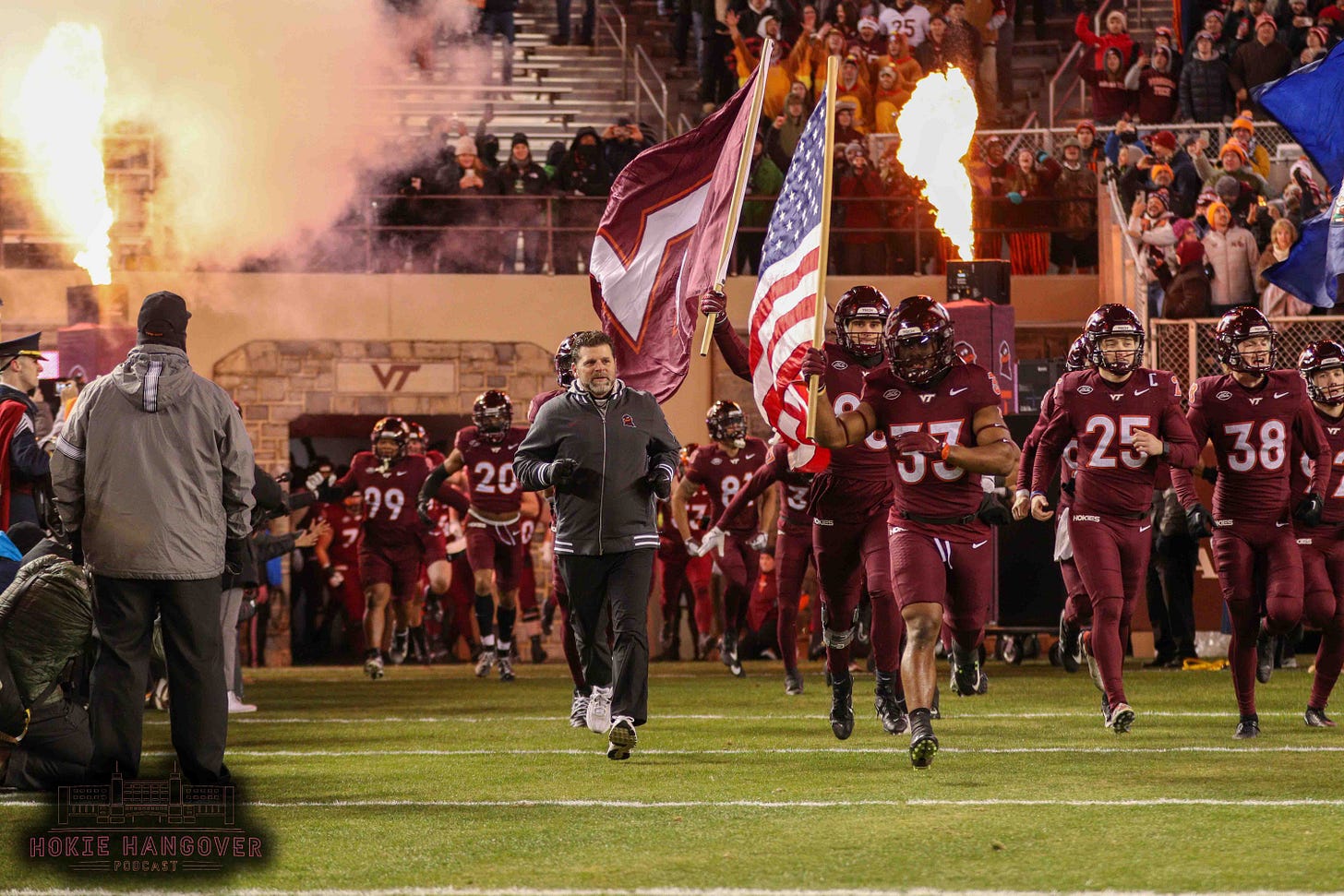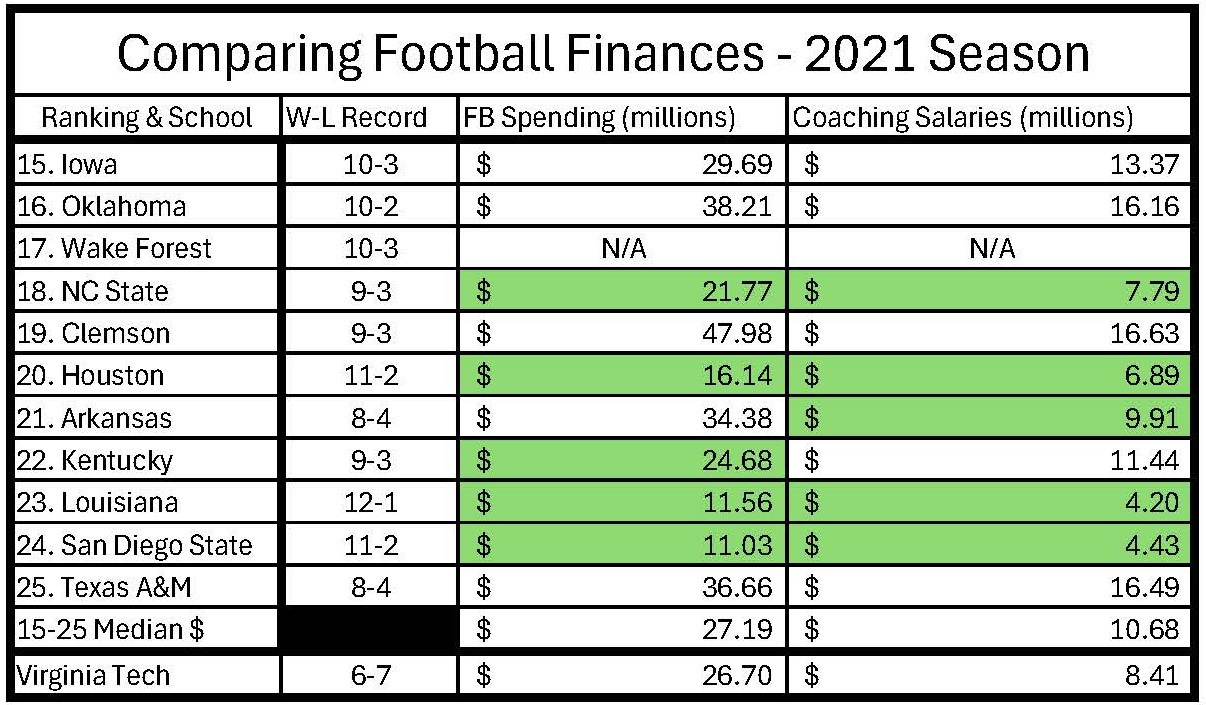Yes, Virginia Tech Has the Resources to Compete
It's time to debunk the narrative that Virginia Tech is being asked to do more with less.

As Brent Pry enters Year Four of his coaching tenure in Blacksburg, there is no better time to make one thing abundantly clear.
Virginia Tech has the resources to compete at the level that fans expect them to.
Relative to the blue bloods of the sport — the Georgias, the Alabamas, and the Ohio States — Virginia Tech is falling further and further behind. Media rights deals for the SEC and Big Ten have vaulted their programs into new financial heights, creating windfalls of cash to support increased coaching salaries, infrastructural improvements, recruiting budgets, and NIL resources.
While that gap grows, it’s important to note that Virginia Tech isn’t far behind their peers of the sport. In fact, depending on how you measure it, the Hokies are in prime position to compete for a spot in the top 25 every year.
Alas, we know that has not been the case. Since 2021, the Hokies haven’t won more than seven games in a season, let alone sniff the Top 25 polls, an achievement the Hokies grew bored from 1995 through 2011.
A common refrain from fans is that while Virginia Tech has not successfully replaced the Beamer regime, the program simply lacks the resources necessary to compete.
To that, I call b******t.
Comparing Virginia Tech to the Rest of the Country
Despite falling behind their SEC and Big Ten peers, Virginia Tech is in a relatively privileged position when it comes to football resources.
See the below data regarding overall football expenditures from 2021-2024, courtesy of the Knight-Newhouse College Athletics Database.
2021
Virginia Tech Football Spending: $26.7 million
ACC Median Football Spending: 25.29 million
FBS Median Football Spending: $16 million
2022
Virginia Tech: $41.77 million
ACC Median: $34.72 million
FBS Median: $21.29 million
2023
Virginia Tech: $32.45 million
ACC Median: $34.52 million
FBS Median: $23.14 million
2024
Virginia Tech: $40.98 million
ACC Median: $39.42 million
FBS Median: $31.36 million
(Note: As some are private schools, not all ACC or FBS programs report their finances publicly.)
While outpacing the median FBS program in terms of football expenditures, Virginia Tech has also beat the median ACC program in spending three of the last four years.
Despite spending more than most of their peers, Virginia Tech has not kept pace where it really matters — in the win column.
Comparing Virginia Tech to the Top 25
The more salient point of this column is not to point out that the Hokies can keep up with the average ACC and FBS program, but that based on spending, Virginia Tech has the funding to compete in the Top 25.
Here’s more data from the Knight-Newhouse database, this time comparing Virginia Tech’s football spending since 2021 with each program that finished in the 15-25 range in the final College Football Playoff ranking.

Still dealing with the aftereffects of the COVID-19 lockdowns, Virginia Tech mustered a 6-7 season despite spending comparable resources with five teams that finished in the 15-25 range. That doesn’t include Wake Forest, who likely has less to work with than Tech does.

In case you’re missing the developing trend — Virginia Tech’s financial spending is very competitive with many teams finishing inside the 15-25 range. The Hokies may be less competitive when it comes to coaching salaries, but the money is there. Sadly, the results were not, as Tech finished 3-8 in Brent Pry’s first year.

The Hokies were less competitive this year in terms of spending, but still spent more money than five teams inside the bottom part of the rankings. Still, the Hokies lagged where it matters — the win-loss column.
More of the same for Virginia Tech, although the Hokies’ deficit in spending on coaching salaries is more pronounced.
It’s Time for Results
No reasonable fan expects Virginia Tech to compete at an elite level in the current landscape of college football. Those programs have such a large advantage in resources, whether it be overall program spending or investment in coaching and staff. That gap exists in the NIL space as well — something much more difficult to analyze.
However, saying that Virginia Tech lacks the resources to compete is a cop-out and a way to deflect blame from the individuals in charge. The Hokies do not have the funding to realistically compete for national championships, but they do have the funding to compete in the top 25.
Despite having the means, the Hokies haven’t come close to meeting that standard. Brent Pry has been the beneficiary of increased resources in recent years — the Hokies are spending more money than many of their peers in the ACC and across FBS, but aren’t winning the games that should come with those expenditures.
It’s time for Pry and his staff to win. Fans should hold their program to a higher standard, given what Virginia Tech is spending on football.
To that end, there should be no doubt that these expectations are reasonable and fair. The data makes that very, very clear.
The House Settlement
While writing this column, the well-covered yet still mysterious House settlement was approved, ushering in a new era of college athletics. Based on reports from those that have covered this from start-to-finish, the settlement has three key points:
Back-pay for former athletes
Capped revenue sharing with current athletes
New enforcement organization regulating revenue sharing and NIL deals
The specifics of these settlements seem to be in flux, though the new enforcement agency, the College Sports Commission, has already hired a CEO to enforce new regulations on money paid to athletes.
How the House deal impacts each program individually and the sport in general is up for debate, but one would think that more strict enforcement of paying players would help level the playing field for programs like Virginia Tech. There will undoubtedly be those that attempt to circumvent the system, but it should help middle-tier programs like Tech hold their own.
Virginia Tech’s Financial Future
Regardless of the specifics, Virginia Tech will face the same challenges and obstacles as everyone else when it comes to operating within the new system. Based on the data presented, the Hokies possess the resources necessary to compete. It all comes down to putting the right people in place, which as we’ve seen over the last several years, is easier said than done.
It also depends on the administration’s ability to capitalize in existing and new revenue opportunities, whether it be fundraising efforts, third-party NIL opportunities, sponsorships, or the ACC’s media rights agreement with ESPN. Tim Sands and Whit Babcock, or whoever will be running the show down the road, will need to secure Virginia Tech’s financial future.


